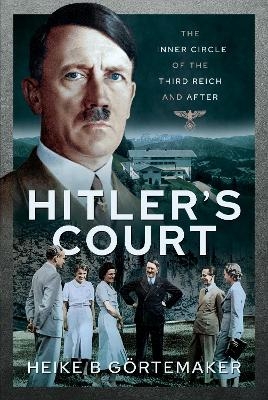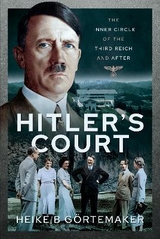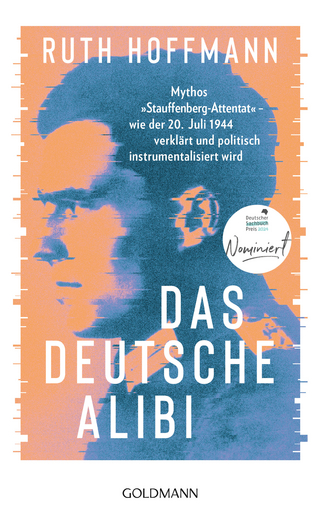Hitler's Court
The Inner Circle of The Third Reich and After
Seiten
2021
Pen & Sword Military (Verlag)
978-1-5267-9070-5 (ISBN)
Pen & Sword Military (Verlag)
978-1-5267-9070-5 (ISBN)
The truth behind Hitler's inner circle.
The people involved and their role in the politics of Nazi Germany.
How much influence did they have on Hitler and his decisions?
What happened to the inner circle after the war?
Hitler was not a lonely, aloof dictator. Throughout his rise in the NSDAP, he gathered a loyal circle around him, which later took on the features of a regular court, and was surrounded by people who celebrated, flattered and intrigued him.
Who belonged to this inner circle around Hitler? What function did this court fulfill? And how did it influence the perception of history after 1945? Using previously unknown sources, Heike Gortemaker explores Hitler's private environment and shows how this inner circle made him who he was.
Biographies of Hitler often concentrate on his obsession with self-image: "If you subtract what politics is about him, little or nothing remains," said Ian Kershaw, and Joachim Fest asserted: "He did not have a private life." For Alan Bullock the "Fuhrer" was an "uprooted man without a home or family". Hitler's inner circle, the Berghof Society, was his private retreat. But the court was more than that. It provided him with the support he needed to be able to take on the role of "Fuhrer" at all, while at the same time allowing him to use its members as political front men. Most of all, it represented a conspiratorial community whose lowest common denominator was anti-Semitism.
In this book, Heike Gortemaker asks new questions about the truth behind Hitler's inner circle and, for the first time, also examines the "circle without leaders"; the networking of the inner circle after 1945.
The people involved and their role in the politics of Nazi Germany.
How much influence did they have on Hitler and his decisions?
What happened to the inner circle after the war?
Hitler was not a lonely, aloof dictator. Throughout his rise in the NSDAP, he gathered a loyal circle around him, which later took on the features of a regular court, and was surrounded by people who celebrated, flattered and intrigued him.
Who belonged to this inner circle around Hitler? What function did this court fulfill? And how did it influence the perception of history after 1945? Using previously unknown sources, Heike Gortemaker explores Hitler's private environment and shows how this inner circle made him who he was.
Biographies of Hitler often concentrate on his obsession with self-image: "If you subtract what politics is about him, little or nothing remains," said Ian Kershaw, and Joachim Fest asserted: "He did not have a private life." For Alan Bullock the "Fuhrer" was an "uprooted man without a home or family". Hitler's inner circle, the Berghof Society, was his private retreat. But the court was more than that. It provided him with the support he needed to be able to take on the role of "Fuhrer" at all, while at the same time allowing him to use its members as political front men. Most of all, it represented a conspiratorial community whose lowest common denominator was anti-Semitism.
In this book, Heike Gortemaker asks new questions about the truth behind Hitler's inner circle and, for the first time, also examines the "circle without leaders"; the networking of the inner circle after 1945.
Dr Heike B. Gortemaker, born in 1964, is a German historian and author. She studied History, Economics and German Literature in Berlin and Bloomington, Indiana. In 2005 she published a biography of Margret Boveri, a prominent German journalist from the 1930s to the 1970s. In 2010 she wrote the best seller _Eva Braun: Life with Hitler_, which was translated into 15 languages. She appears frequently in TV documentaries on the Third Reich and lives with her husband near Berlin.
| Erscheinungsdatum | 31.01.2022 |
|---|---|
| Verlagsort | South Yorkshire |
| Sprache | englisch |
| Maße | 156 x 234 mm |
| Themenwelt | Geisteswissenschaften ► Geschichte ► Allgemeines / Lexika |
| Geschichte ► Allgemeine Geschichte ► 1918 bis 1945 | |
| Geschichte ► Teilgebiete der Geschichte ► Militärgeschichte | |
| ISBN-10 | 1-5267-9070-X / 152679070X |
| ISBN-13 | 978-1-5267-9070-5 / 9781526790705 |
| Zustand | Neuware |
| Haben Sie eine Frage zum Produkt? |
Mehr entdecken
aus dem Bereich
aus dem Bereich
ein Psychologe erlebt das Konzentrationslager
Buch | Hardcover (2024)
Kösel (Verlag)
22,00 €
Mythos „Stauffenberg-Attentat“ – wie der 20. Juli 1944 verklärt und …
Buch | Hardcover (2024)
Goldmann (Verlag)
24,00 €




